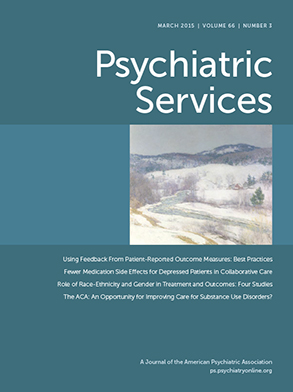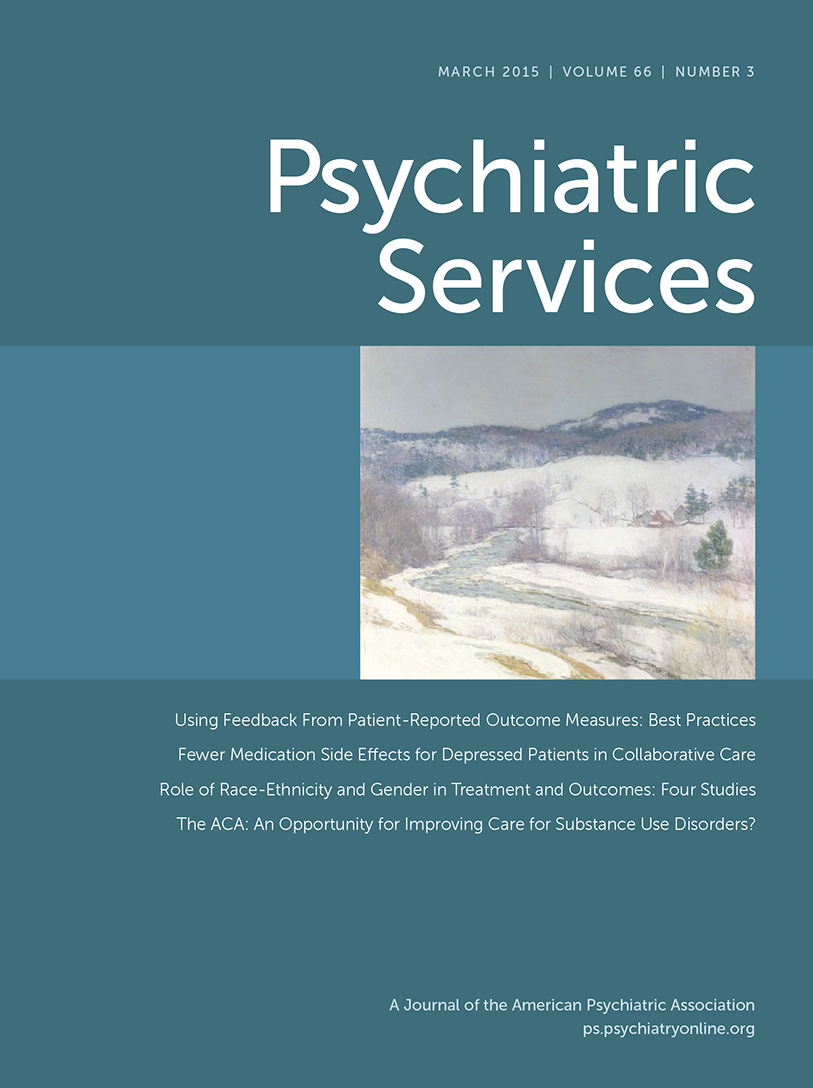Living without stable housing severely increases risk of morbidity and mortality (
1–
3). Compared with the general population, individuals experiencing homelessness have higher rates of general medical and behavioral health conditions (
3) and an increased risk of death (
2). Research has identified gender-based health disparities among individuals experiencing homelessness, with female gender predicting poor health (
3–
7). Although individuals experiencing homelessness may have greater health care needs than their housed counterparts, they experience greater barriers to health care access and have greater unmet need (
7–
10).
Health conditions experienced by the general homeless population may be amplified among veterans. Compared with homeless males in the general population, homeless male veterans are more likely to experience chronic general medical conditions (66% versus 55%) and two or more mental health conditions (33% versus 22%) (
11). A unique quality of the veteran population is that veterans often have access to health care and other services through the U.S. Department of Veterans Affairs (VA). Although a significant proportion of veterans are enrolled in Veterans Health Administration (VHA) health care, no population-based study has identified disparities in housing stability on the basis of general medical, cognitive, and behavioral health comorbidities. This information is critical to ensuring that the system identifies veterans experiencing housing instability who have complex health needs and intervenes to mitigate risk, in terms of both housing and health.
The focus of this study was to detect disparities in housing status related to general medical, cognitive, and behavioral health conditions in a nationally representative sample of U.S. veterans receiving VHA health care. Using Kilbourne and colleagues’ (
12) three-phase framework for conducting health disparities research as a guide, we explored the relationship between comorbid health conditions and housing status to determine whether differences in housing outcomes constitute disparities.
Methods
Data were extracted from VHA clinical and administrative systems. The dependent variable is based on veterans’ responses to the VHA Homelessness Screening Clinical Reminder (HSCR), a universal screen for housing instability that is administered to all veterans seeking health care at any VHA outpatient facility who are not receiving services through a VHA homeless program. The HSCR assesses whether veterans are experiencing current homelessness or imminent risk. Independent variables include age (categorized into five groups), race (white, black, or other), four medical comorbidities that were most prevalent among the study population, and eight cognitive or behavioral health comorbidities (
13).
The cohort comprised all veterans who responded to the HSCR between November 1, 2012, and January 31, 2013. The final sample did not include veterans who declined screening or had missing, incomplete, or duplicate responses (N=23,177, 1.4%) and who did not have an outpatient visit six months prior to screening (N=37,690, 2.3%).
We conducted analyses separately for men and women to identify specific risk factors by sex because VHA’s patient population is predominantly male and previous literature has identified gender-based differences in health and social factors among individuals who experience homelessness (
14). We calculated adjusted odds ratios using multinomial mixed-effects models, with age, race, and the comorbidity of interest as covariates. Models included facility-specific random intercepts. We calculated Bonferroni-corrected p values and confidence intervals to account for the 13 comparisons. This study was approved by the Philadelphia VA Medical Center Institutional Review Board.
Results
The sample included 1,582,125 veterans: 6.8% were women and 93.2% were men. A majority (62.8%) of women were younger than 55 years and identified as white (58.4%); 25.1% of women identified as black. A majority of men (79.7%) were older than 55 years and identified as white (69.9%); 13.3% of men identified as black. Overall, .8% of the sample reported homelessness (N=11,909), 1.1% (N=16,654) reported risk of homelessness, and 98.2% (N=1,553,562) were negative for both homelessness and risk. The proportion of positive screens was 2.7% among women (N=2,842) and 1.7% (N=25,721) among men.
Table 1 presents age- and race-adjusted odds of screening positive for homelessness or homelessness risk as a function of general medical, cognitive, and behavioral health comorbidities. Among women, none of the general medical comorbidities was associated with an increased likelihood of screening positive for homelessness; however, diabetes was associated with increased odds (OR=1.28) of homelessness risk. For men, having hypertension or diabetes was associated with a lower likelihood of homelessness but not with risk of homelessness; men with chronic pulmonary disease were more likely to screen positive for both homelessness and risk of homelessness.
Among both men and women, having any cognitive or behavioral health condition except traumatic brain injury increased the likelihood of screening positive for homelessness or risk by a factor of close to or more than two. Each behavioral health condition was significantly and positively associated with housing status; the effect sizes were larger for homelessness than for risk. Women with a diagnosis of drug abuse or with a suicide attempt or intentional self-inflicted injury were more than four times as likely as those without these conditions to screen positive for homelessness. Men with a diagnosis of drug abuse had a nearly fivefold greater likelihood of screening positive for homelessness, and those with a suicide attempt or intentional self-inflicted injury were more than six times as likely to screen positive for homelessness.
Discussion
This study was intended to identify disparities in veterans’ reports of homelessness or risk of homelessness on the basis of general medical, cognitive, and behavioral health conditions. Separate analyses for women and men controlled for differences in sample size and demographic composition between the two populations (
13). The sample comprised veterans who accessed VHA health care services but not homeless services, which is the primary population that the HSCR was developed to detect.
There was a clear association between cognitive and behavioral health conditions and housing status; however, the relationship between general medical conditions and housing status was more complex. For both genders, the odds that medical conditions would increase the likelihood of homelessness or homelessness risk were inconsistent. That cognitive and behavioral health conditions but not necessarily general medical conditions were associated with an increased likelihood of homelessness or risk may be attributable to strain on social capital associated with these conditions, which would make maintaining social networks, accessing services, and sustaining employment and housing difficult for these veterans (
15).
The study had several limitations. Health conditions described here are based on diagnoses reported in VHA medical records; however, veterans may have had undiagnosed conditions or may have sought health care elsewhere. The housing status categories (homeless, at risk, and negative) were based on patient self-report and may have been subject to reporting bias. This study may have underestimated the frequency of homelessness in the veteran population because the sample did not include veterans who did not access VHA health care or veterans who accessed a VHA homeless program in the previous six months. Veterans with the most disabling conditions and poor housing status may not have been represented in the sample because their access to care may have been limited. Therefore, we cannot generalize beyond the population of veterans engaged in VHA services. Finally, the data were cross-sectional and thus we cannot speak to the temporal order or mechanisms linking health conditions to homelessness.
This study found a disparity in housing status related to cognitive and behavioral health conditions among VHA outpatients, which suggests that the health care system should address two issues. First, it must provide targeted outreach to veterans with these conditions who are experiencing housing instability. Second, housing assessments and interventions should be designed to identify and mitigate both housing instability and health-related concerns. Appropriate interventions may include housing-related services ranging from short-term, inexpensive interventions (for example, temporary financial assistance) to long-term, expensive interventions (for example, permanent supportive housing) (
15).
VA currently supports two large, national-level programs that provide these services: the Supportive Services for Veteran Families program provides short-term housing interventions for veterans in the community, and the U.S. Department of Housing and Urban Development–VA Supportive Housing program supports veterans requiring both a deep rental subsidy and more intense services. VA has developed Homeless Patient Aligned Care Teams to address chronic general medical, cognitive, and behavioral health conditions in the homeless and at-risk veteran population. These multidisciplinary teams provide care tailored to the needs of a homeless population with the objective of transitioning these veterans to housing stability and improving their health.
Conclusions
The study found clinically and statistically significant differences in housing stability among veterans with selected comorbid health conditions. Future research will examine the interactions of factors at multiple levels: the veteran level—individual risk factors and barriers and facilitators to service access—and the VA organizational level, including the system’s ability to accurately identify at-risk veterans and link them with interventions. These findings, with a focus on mutable variables, will inform developments in policy and practice to reduce disparities in housing status and improve VA’s ability to identify at-risk veterans and inform existing interventions. Future investigation should consider the potential aggravating and mitigating factors influencing disparities in housing status outside of the VHA patient population.
Acknowledgments
This study was funded by the U.S. Department of Veterans Affairs (VA), National Center on Homelessness Among Veterans and a Competitive Pilot Research Grant (LIP 72-061) by the VA Center for Health Equity Research and Promotion. The contents of this article do not necessarily represent the views of the VA or the United States Government.
The authors report no financial relationships with commercial interests.

